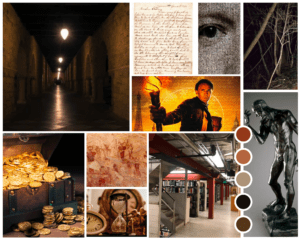For my moodboard and Spotify playlist, the game I focused on is “Stanford Treasure Hunt” which focuses on players uncovering the whereabouts of a secret treasure belonging to the Stanford family buried somewhere on campus. Through narrative and fellowship, the players must race against the clock to find out exactly where the treasure is hidden.
Moodboard

Spotify Playlist
Three Directions for the Game:
- Stanford Treasure Hunt (moodboard corresponds to this idea)
- Premise:
- A student is checking out a book from the West Stacks and finds an old, forgotten letter tucked between the dusty pages. The letter is from Leland Stanford himself. Inside the letter, he discloses that there is a secret treasure somewhere on Stanford’s campus, but in order to find it / access it, a series of challenges must be met, challenges that only the best and the brightest can complete.
- Types of fun:
- Fellowship – players will need to work together to solve the puzzles and receive the next clue. We will need to ensure that some of our challenges involve teamwork
- Puzzle Ideas:
- Cipher Challenge: Provide a ciphered message that needs to be decrypted using a specific cipher method (e.g., Caesar cipher, substitution cipher) to reveal the next clue.
- Campus Trivia: Create a series of trivia questions related to Stanford’s history, landmarks, or notable figures. Players must answer the questions correctly to proceed to the next clue.
- QR Code Scavenger Hunt: Hide QR codes throughout the campus, each leading to a different clue. Players need to locate and scan the QR codes using a mobile device to unveil the next hint.
- Cryptic Riddles: Present players with a set of cryptic riddles that lead them to specific locations on campus. They must solve the riddles and find the corresponding locations to discover the next clue.
- Morse Code Challenge: Transmit a message in Morse code using lights, sounds, or written symbols. Players must decode the Morse code message to uncover the next clue.
- Image Manipulation: Provide players with a distorted image that needs to be corrected or enhanced using image editing techniques. Once the image is fixed, it reveals the next clue.
- Premise:
- Stanford Art Heist
- Premise
- One of the famous art pieces at Cantor has gone missing and Stanford has put out a million dollar reward to whoever can help them find the thief.
- Players are asked to be detectives and find out “whodunit”
- Types of fun
- Narrative – This version of the game would be very focused on building out the story itself and would involve players needing to be detectives and solve a mystery.
- Discovery – As the game progresses and clues are given, more of the story and world unfolds. Players have fun as they journey through the story and uncover clues and hints to solve the mystery of who stole the painting
- Challenge – In order to uncover certain clues and advance the game, players will have to complete / crack puzzles.
- General notes
- More narrative based and centered on the mystery and the unfolding of the story
- Is meant for one person to play on their own in competition with the other players
- Time is a precious resource – racing other players to solve the mystery first!
- Could include art related challenges
- Art trivia
- Making artwork with their team
- Premise
- Escape from Giza
- Premise
- A Stanford archaeology team was sent to Egypt to study the Great Pyramid of Giza. An earthquake hit, so the entrance you used to get in and out of the pyramid has been closed. You and your team have to find your way out. There is a sense of urgency as the Egyptian myths say that if you are in the tombs at sundown, the mummy’s spirit will be traded with your own and you will be trapped in their mummified body
- Would be “escape room in a box”-esque
- Type of fun
- Challenge – have to complete tasks and gather resources in order to find a viable way out under a given time limit
- Discovery – finding out more about the surrounding world.
- Fellowship – would be encouraged to work together to uncover clues needed to get out of the pyramid in the given time
- Puzzle Ideas
- Hieroglyphics Translation: Create a set of hieroglyphic symbols and provide players with a translation guide. They must decipher the hieroglyphics to reveal the next clue.
- Symbolic Maze: Design a maze filled with symbolic clues and riddles. Players must navigate through the maze and correctly interpret the symbols to determine the correct path to the next clue.
- Audio Puzzle: Play a recorded audio clip with hidden clues embedded within it. Players need to listen carefully and identify specific words, sounds, or patterns to progress to the next clue. Audio could be ancient sounds that happen just before sundown or the mummy slowly “coming alive” and speaking to the people in the pyramid.
- Premise


